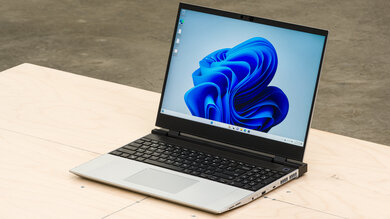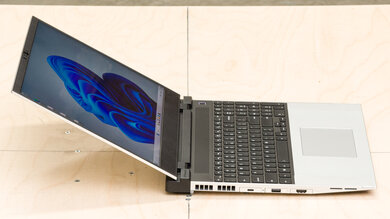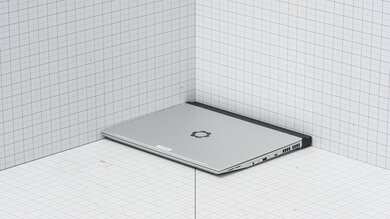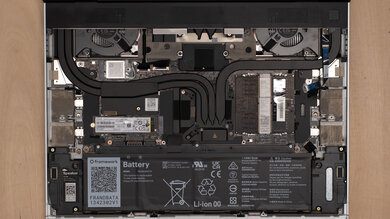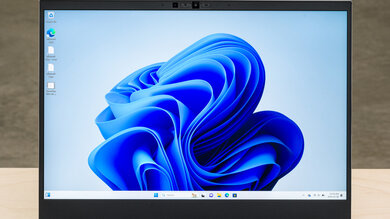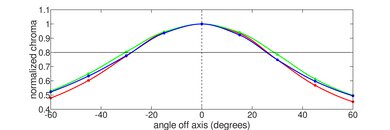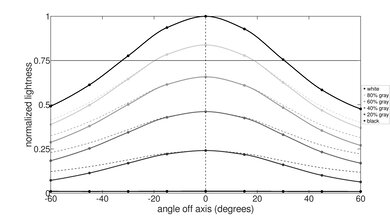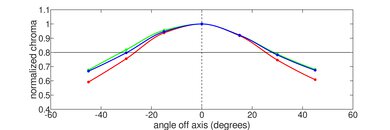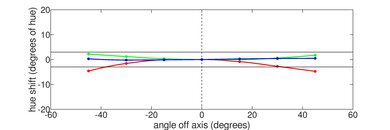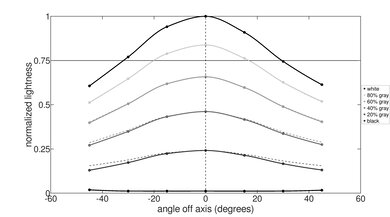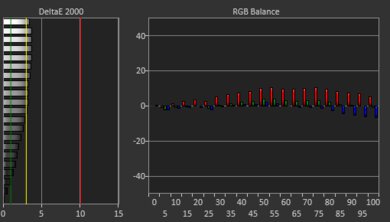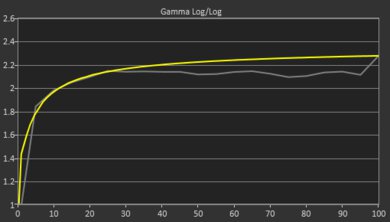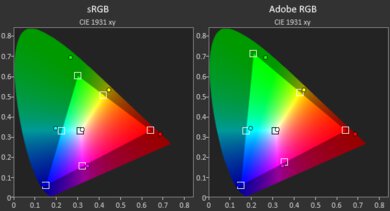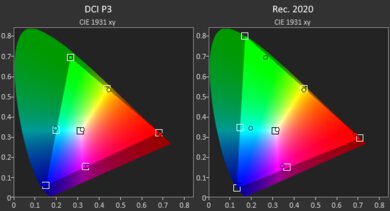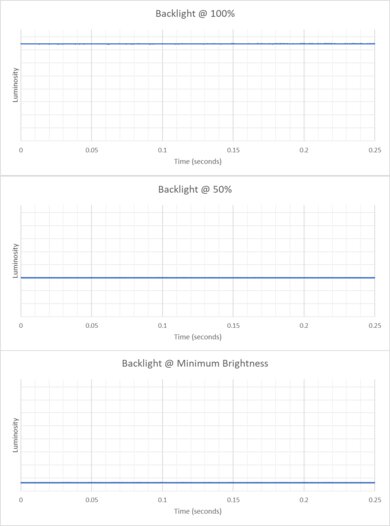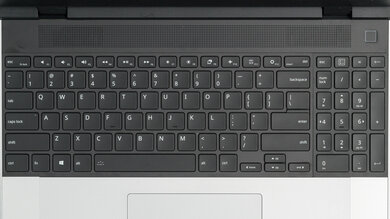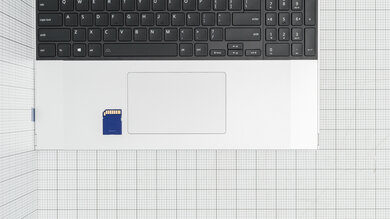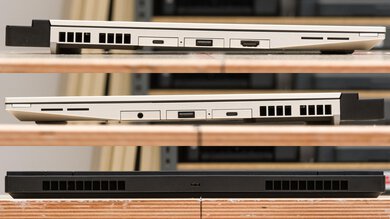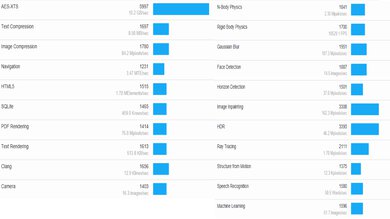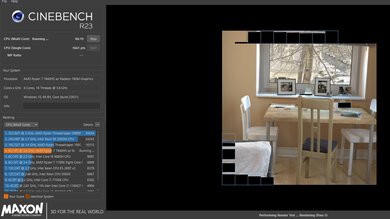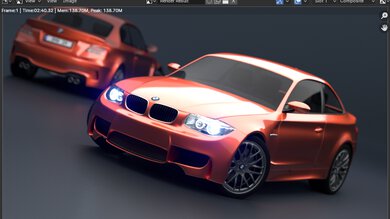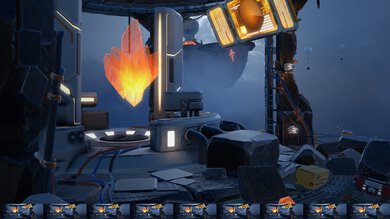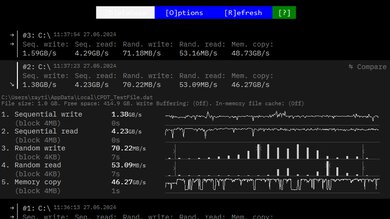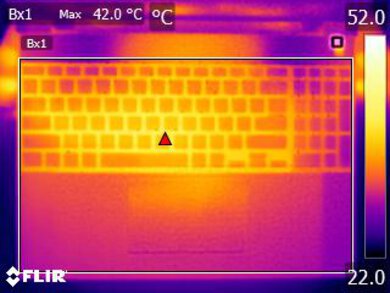The Framework Laptop 16 (2023) is a modular Windows laptop for gaming and content creation. This AMD Ryzen-based model is a new addition to Framework's lineup. This is the first time the company has offered a 16-inch form factor and a discrete GPU option. Like all Framework laptops, you can get a pre-configured model or go the DIY route to choose each component individually. You can configure this model with a Zen 4-based AMD Ryzen 7 7840HS or Ryzen 9 7940HS CPU, an AMD Radeon RX 7700S discrete GPU, up to 64GB of RAM, and up to 4TB of storage. It has a 2560 x 1600 165Hz IPS display with FreeSync support and full DCI P3 coverage, a 1080p webcam, Wi-Fi 6E, and multiple keyboard and input module options, including a numpad and macropad that are user-configurable via QMK.
See our unit's specifications and the available configuration options in the Differences Between Variants section.
Our Verdict
The Framework 16 is decent for school use. The main draw of this laptop is its performance and display. It has plenty of power for 3D modeling, rendering, or programming workloads, and its display offers full DCI P3 coverage, making it a great choice for students in graphic design or photo and video editing. By contrast, the user experience is just okay overall. The touchpad and keyboard are good enough, but nothing special, and its battery life is fine but won't get you through a full day of classes. Its 16-inch form factor isn't particularly portable, and, finally, the build quality is just okay; while the materials generally feel durable, the laptop's modular design results in gaps and creases where the different modules connect. These creases are sharp and can scratch you.
- Sharp, bright display with excellent color coverage.
- Hardware can handle demanding workloads.
- Expansive configuration options.
- Large and bulky design.
- CPU thermal throttles and fans get loud.
- Fit issues with modular components.
The Framework 16 is excellent for gaming. It's available with AMD Ryzen 7 or 9 CPUs and an AMD Radeon RX 7700S discrete GPU, which provides a smooth gaming experience at 1080p or 1440p. The 165Hz QHD+ display delivers a clear image with minimal ghosting and supports FreeSync, so you don't need to worry about screen tearing. If you choose the DIY model, you can get up to 6TB of storage to house your game library. The pre-built models max out at 1TB of storage, but you can add more yourself. The laptop stays cool enough to enjoy long gaming sessions, but the fan gets quite loud.
- 165Hz refresh rate with fast response times and FreeSync support.
- Expansive configuration options.
- Delivers smooth gameplay in demanding games.
- CPU thermal throttles and fans get loud.
The Framework 16 is decent for multimedia consumption. Its best feature is the large 16-inch display, whose wide color gamut makes video content pop. Moreover, it gets bright enough for indoor and outdoor use, and the matte coating on it does a great job minimizing reflections from lights or sunlight. The speakers certainly get loud but don't sound particularly good; they have a stuffy sound signature, lacking both treble and bass. Battery life is also just okay. Finally, because the laptop is so large, it isn't particularly portable if you want to watch videos while traveling on a plane or bus.
- Sharp, bright display with excellent color coverage.
- Large and bulky design.
The Framework 16 is excellent for use as a workstation. It's available with AMD Ryzen 7 or 9 CPUs and an AMD Radeon RX 7700S discrete GPU; both perform well and have plenty of processing power to handle demanding tasks like video editing, programming, and 3D animation. You can also perform color-correction tasks, as it has a QHD+ display with full DCI P3 coverage. As the RAM and storage are fully user-replaceable, you don't need to worry about tailoring either of these components to your workflow. The modular port system is fantastic, as you can swap out the ports on the go to attach almost any peripherals you need. Otherwise, the user experience is okay overall, as the keyboard and touchpad are fine to use.
- Sharp, bright display with excellent color coverage.
- Hardware can handle demanding workloads.
- Expansive configuration options.
- Fast storage.
- CPU thermal throttles and fans get loud.
The Framework 16 is good for business use. Its modular port system is great, allowing you to change the ports on the fly for whatever you need. The 16-inch display is large and features a 16:10 aspect, which is great for working with multiple documents or spreadsheets and for giving you some extra vertical real estate. Its battery life is okay but won't last you a full day of work, and because it's a larger laptop, it isn't the best choice if portability is a priority. The big disappointment is the build quality and user experience; they're both just okay. The laptop's modular design results in gaps and creases where the different modules connect. These creases are sharp and can scratch you. As for the touchpad and keyboard, while both are fine, they don't offer a premium experience. There are some tracking and palm detection issues, and the keyboard feels mushy.
- Sharp, bright display with excellent color coverage.
- Expansive configuration options.
- Large and bulky design.
- Fit issues with modular components.
Changelog
- Updated Jun 26, 2024: We've updated the review to describe the hardware privacy switch for the webcam and microphone.
- Updated Jun 17, 2024: We've updated the review to reflect the availability of RGB keyboard variants.
- Updated Jun 13, 2024: Review published.
- Updated Jun 05, 2024: Early access published.
Check Price
Differences Between Sizes And Variants
We tested the pre-built Performance model of the Framework Laptop 16 (2023). This configuration includes an AMD Ryzen 7 7840HS CPU, AMD Radeon RX7700S GPU, 16GB of RAM, and 512GB of storage. You can get a pre-configured model or a DIY edition; the latter allows you to choose most components individually. The available options are in the tables below.
| Pre-built Models | Specifications |
|---|---|
| Performance |
|
| Performance Pro |
|
| Overkill |
|
| DIY Edition | Configuration |
|---|---|
| Screen |
|
| CPU |
|
| Memory |
|
|
Primary Storage (M.2 2280) |
|
|
Secondary Storage (M.2 2230) |
|
| OS |
|
| Expansion Bay System |
|
| Input Modules |
|
| Bezel Color |
|
|
Add-Ons (Extra Spacers) |
|
The Framework Laptop 16 is only available on Framework's website. See our unit's label here.
Popular Laptop Comparisons
The Framework Laptop 16 (2023) is a Windows laptop for gaming and content creation. Its modular design offers industry-leading options for repairability and expandability. The display is much improved over previous Framework offerings. However, unlike its smaller sibling, the Framework Laptop 13 (2023), the build quality and user experience are just okay overall. The fit of the different modules creates numerous spaces and gaps, the screen exhibits significant flexing, the keyboard feels mushy, and the speakers aren't great. That being said, performance is good overall as the CPU and discrete GPU are well-suited to intensive tasks. All in all, this is a great laptop if you want a modular device, but it gets expensive quickly, and there are better options if performance is your main concern.
For more options, check out our recommendations for the best 15-16 inch laptops, the best gaming laptops, and the best video editing laptops.
Both the Framework Laptop 16 (2023) and Framework Laptop 13 (2023) are modular laptops, but they target different audiences. The 13-inch is an ultraportable device designed for general productivity tasks on the go, whereas the 16-inch model is designed for gaming and content creation tasks like video editing. As a result, the 13 comes with low-power AMD and Intel CPUs, a 2256 x 1504 3:2 IPS display, and all-day battery life. The 16-inch model features faster AMD CPUs, is Framework's first offering with a discrete GPU, and also features a brighter QHD+ IPS panel with full coverage of the DCI P3 color space. Unfortunately, the build quality falls short of the smaller sibling, as there are numerous fit issues between the various modular components.
While the Framework Laptop 16 (2023) and Lenovo Legion Pro 5 Gen 8 16 (2023) offer similar performance for intensive use cases, the user experience is better overall on the Lenovo. The Lenovo laptop features a better keyboard, touchpad, and build quality than the modular Framework, as there are numerous fit issues between the components. That being said, the Framework offers a display with full coverage of the DCI P3 color space, making it the better choice for business or content creation applications like video editing, and its modular port system means you can swap ports out on the go to suit your needs. Moreover, while the Framework falls short of full-day battery life, it is much better than the Lenovo's which lasts just under five hours for light use.
The Apple MacBook Pro 16 (M3, 2023) is a much better laptop for most use cases than the Framework Laptop 16 (2023). With Apple's M3 SoC, the Macbook Pro is a very capable mobile workstation that offers a much more premium user experience than the Framework with its Mini LED display, large touchpad, spacious keyboard, and fantastic up-firing speakers. It also features much better battery life than the Framework laptop. By contrast, if you want to game, then the Framework is the better choice as it offers far better performance than the Apple. This is partly because very few games are optimized for its ARM-based SoC, and running games through Rosetta 2 can result in poor performance or graphical glitches, depending on the game. Finally, the modular port system on the Framework offers much better versatility, as you can swap out ports on the go.
The Dell XPS 16 (2024) is better overall than the Framework Laptop 16 (2023), although they target somewhat different uses. The Dell is a premium Windows workstation laptop whose hardware is versatile enough for gaming; the Framework is a modular laptop for gaming and content creation applications like video editing. The real differences come down to the user experience. The build quality is vastly superior on the Dell, as the fit of the Framework's modular design results in gaps and exposes sharp edges. Moreover, while not fault-free, the keyboard and trackpad are also much better on the Dell. The Framework is very loud under load, something that can't be said of the Dell. Finally, the modular port system on the Framework offers much better versatility, as you can swap out ports on the go.
Test Results

The display bezel is customizable with different colors, including black, orange, and lavender. Extra spacers are available in black, orange, gray, lavender, color shift, as well as a programable LED Matrix. See the bottom of the Framework 16 here.
The build quality is decent for the Framework 16. The chassis is magnesium alloy, the cover is aluminum, and there are plastic pieces throughout. It feels solid, and there's only a little flex in the keyboard deck. While the materials generally feel durable, the laptop's modular design results in gaps and creases where the different modules connect to each other and the chassis. The edges of the spacers around the touchpad are sharp and can scratch you. Similarly, the display assembly lacks rigidity and flexes quite easily, likely due to the customizable bezels. The black plastic finish above the keyboard scratches easily, and the power button picks up fingerprints and smudges after some use. That being said, there are no complaints about the feet or the balance of the laptop; the feet feel solid, and the weight is well distributed.
The hinge is outstanding. It feels smooth and has a moderate amount of resistance, allowing you to easily lift the lid with one hand. Because of the flex in the display assembly, there's some wobble when you adjust the screen; however, the wobble isn't present when typing heavily.
Everything is replaceable in the Framework Laptop 16, including the display, frame bezels, keyboard and numpad, GPU, and more. Accessing the internals is a bit more labor intensive than with its smaller sibling, the Framework Laptop 13 (2023), but everything is well-labeled and easy to work with. You need to undo a total of 16 T5 screws (these are captive, thankfully), and then disconnect the ribbon cables from the keyboard and trackpad to access the motherboard. If you want to use the Expansion Bay Module, you'll need to remove additional screws and clips from the Graphics Module. Although most parts are proprietary to Framework, the RAM and storage are replaceable with compatible parts from any brand.
See the support and service guides here.
The Framework 16's display looks sharp and provides ample room for multitasking, as you can comfortably fit at least two windows side by side. It features a 16:10 aspect ratio, providing you with additional vertical real estate compared to the more traditional 16:9 aspect ratio. This is great when web browsing or reading articles, as you don't need to scroll as much. The trade-off is that you will almost always get letterboxing on the top and bottom when watching videos.
The response time of the Framework 16's 165Hz display is outstanding. There's very minimal ghosting behind fast-moving objects. It also supports FreeSync variable refresh rate technology, so you don't need to worry about screen tearing when playing games with an uncapped frame rate.
This display gets bright enough for use in almost all indoor settings. Depending on the content and viewing conditions (whether the sun is shining directly on the screen or not), it can also get bright enough for outdoor use. It also gets very dim at the lowest setting, which is great for preventing eye strain and fatigue if you want to view content in a dark environment.
The display's matte coating is good at handling reflections. You'll barely notice direct light sources like a lamp or sunlight through your window when the screen is on full brightness, although these will be more apparent when viewing dark content.
The display's horizontal viewing angle is okay. The image dims and washes out fairly quickly when moving to the side. It's best to be close or directly in front of the screen if you need perfect accuracy for color-critical work.
The display's vertical viewing angle is okay. Like the horizontal viewing angle, the image looks dimmer and more washed out from above or below. You'll need to look at the screen more or less straight on to see an accurate image.
The out-of-the-box color accuracy is adequate for this display. The color temperature leans towards the warm side, giving the screen a yellowish tint. Most white balance inaccuracies are fairly minor, but because this display targets a wide color space, the colors look oversaturated and inaccurate. The gamma is too low, over-brightening most scenes.
The display offers a wide color gamut, with near complete coverage of the sRGB and DCI P3 color spaces. This makes it great for color-critical work. It also has excellent coverage of the Adobe RGB color space, but it can't display the highly saturated greens, so it might not be good enough for professional photographers.
The Framework 16's keyboard is great. It offers a spacious layout that's easy to use. While the keys are stable and have a decent amount of travel, they feel mushy, almost like a rubber dome keyboard. This mushiness doesn't provide the most satisfying typing experience.
What is satisfying about this keyboard is the ability to customize its layout, inputs, and position. All keyboards either come with white backlit or per-key RGB lighting; there are also options to add a numpad, macropad, or simple spacers to fill the additional space. You can configure the inputs of the numpad and macropad to your liking, as they run QMK layouts. You can also customize the keyboard position to the left, right, or center of the unit, although the center position only works if you opt for the spacers. The laptop includes the spacers at the time of purchase if you don't purchase the numpad or macropad modules; however, if you choose one of these modules, the spacers cost extra.
The Framework 16's touchpad is decent. While not small by any means, proportionally to the rest of the chassis, its design feels dated. Tracking is great, except for the right edge of the trackpad, which is inconsistent. It tends to work if you begin a movement elsewhere on the touchpad, but it has a hard time detecting inputs when you begin along the right edge. Similarly, while the buttons feel click and work well, you can only click on the bottom half of this touchpad. Finally, palm detection is inconsistent.
The Framework 16's speakers get reasonably loud but are devoid of bass and treble, resulting in a stuffy and congested sound. On the bright side, the speakers don't rattle at high volumes.
The webcam is decent on the Framework 16. It provides a clear and rather detailed image. However, the exposure is too low, and there's some visible noise. While the microphone is clear and you can understand voices well, it's on the quiet side. There is a hardware privacy switch for the webcam and microphone rather than a physical cover; the switch disconnects the webcam and microphone from power, making it impossible for you to use them without flipping the switch again.
The Framework 16 has a modular port system with six slots. The Graphics Module also features a dedicated USB-C port that supports display out and USB 4 data transmission but not charging. Each port is built into a small cartridge that Framework calls 'expansion cards'; they use USB-C to connect with the chassis. You can buy as many expansion cards as you want from the following options:
- USB-A (USB 3.2 Gen 2)
- USB-C (USB 4, charging, DisplayPort Alt Mode)
- DisplayPort (1.4)
- MicroSD (UHS-I)
- HDMI (2.0b)
- Ethernet
- 3.5 mm combo headphone/microphone jack
- 250GB (USB 3.2 Gen 2) Storage drive
- 1TB (USB 3.2 Gen 2) Storage drive
The rear two slots (labeled 1 and 4 on this diagram) pull more power when housing USB-A ports. Similarly, slots 3 and 6 do not support charging the laptop. Slots 3, 5, and 6 do not support video output. See Framework's diagram about port specifications here.
The wireless adapter is an AMD RZ616, also known as the MediaTek MT922A22M. Wi-Fi 6E has faster speeds, lower latency, and less signal interference than previous Wi-Fi standards. However, you'll need a router that supports Wi-Fi 6E to benefit from these features.
The Framework Laptop 16 (2023) is available with the following CPUs:
- AMD Ryzen 7 7840HS (8 cores/16 threads, up to 5.1GHz, 24MB L3 cache)
- AMD Ryzen 9 7940HS (8 cores/16 threads, up to 5.2GHz, 24MB L3 cache)
Both are high-performing 35W CPUs typically found in gaming and workstation laptops. These 7000-series processors were the first generation of AMD CPUs to include a Neural Processing Unit (NPU) for AI-based tasks like image generation in photo editing apps and background blurring during video calls. AMD has released a new 8000 series of CPUs that features better NPU performance but otherwise is a refresh of these 7000-series chips.
These Ryzen 7 and 9 processors can easily handle general productivity tasks and more demanding workloads like gaming, programming, and content creation. Both CPUs have the same core count and cache; what differentiates them is a slight boost in clock speed for the Ryzen 9 processor. Framework advertises a 45W Thermal Design Power (TDP) for these processors of 'continuous processor power,' meaning they should be able to maintain this higher power draw to achieve better performance for intensive workloads.
The Framework Laptop 16 (2023) is available with these GPU options:
- AMD Radeon RX 7700S 8GB GDDR6 (100W TGP) discrete GPU
- AMD Radeon 780M integrated graphics
If you are primarily interested in gaming or performing GPU-intensive workloads like 3D modeling or rendering, get the discrete GPU option. The RX 7700S is a mid-range GPU that competes with NVIDIA's GeForce RTX 4060 and 4070 GPUs. It supports features like ray tracing, hardware-accelerated AV1 encoding, and AMD's frame generation technology, Fluid Motion Frames. It's great for high refresh rate 1080p gaming in modern AAA games and can also provide a great 1440p experience. Ray tracing performance trails its NVIDIA counterparts, however.
Regarding integrated GPUs, the Radeon 780M is at the top of its class. It can handle some graphically intensive games but only at 1080p with low settings. This makes it a good option if you only plan to game once in a while but primarily use your laptop for light productivity tasks like web browsing or video playback. See our review of the Framework Laptop 13 (2023) for performance metrics of the 780M iGPU on a lower power CPU.
This laptop has many RAM configurations. The DIY model has the following RAM options:
- 8GB DDR5 5600MHz (1x 8GB)
- 16GB DDR5 5600MHz (1x 16GB)
- 16GB DDR5 5600MHz (2x 8GB)
- 32GB DDR5 5600MHz (1x 32GB)
- 32GB DDR5 5600MHz (2x 16GB)
- 64GB DDR5 5600MHz (2x 32GB)
- None (bring your own)
- 16GB DDR5 5600MHz (2x 8GB)
- 32GB DDR5 5600MHz (2x 16GB)
The Performance and Performance Pro variants come with 16GB, while the Overkill variant has 32GB. The RAM is user-replaceable. Each SO-DIMM of DDR5 RAM has two channels; therefore, if you plan on upgrading to more RAM down the road, you can select an option with only one DIMM and add another one later without having to worry about sacrificing performance like with the older DDR4 standard.
The Pre-built models have a fixed amount of storage and use M.2 2280 PCIe Gen 4 SSDs. The Performance and Performance Pro variants come with 512GB, while the Overkill variant has 1TB. Pre-built variants all come with Western Digital PC SN810 drives. There's a second M.2 slot using the smaller 2230 format; see the layout here.
The DIY variant has many storage options, including:
- 250GB WD_Black SN770
- 500GB WD_Black SN770
- 1TB WD_Black SN770
- 1TB WD_Black SN850X
- 2TB WD_Black SN770
- 2TB WD_Black SN850X
- 4TB WD_Black SN850X
- None (bring your own)
The secondary storage options include:
- 250GB WD_Black SN770
- 1TB Western Digital SN740
- 2TB Western Digital SN740
- None (bring your own)
The SN850X drives are the fastest; the performance of the the SN770 and the SN740 is the same for 1TB capacities and above. However, the smaller 500GB and 250GB SN770 drives perform worse. If you primarily game, the differences are mostly negligible. However, if you transfer a lot of files locally, the difference in performance will be more noticeable; see the SN740's specifications, SN770's specifications, and SN850X's specifications.
Finally, you can add additional storage with Framework's expansion cards, which use a USB 3.2 Gen 2 interface. There are options for 250GB or 1TB cards; Framework advertises up to 1000 MB/s read and 800 MB/s write speeds for both capacities.
The Framework 16 has an outstanding overall score in Geekbench 5. The AMD Ryzen 7 7840HS has strong single- and multi-thread performance, making it suitable for general productivity tasks and highly demanding workloads. Just know there are significantly faster CPUs on the market for heavy workloads, like the Dell Alienware m18 R2 (2024)'s Intel Core i9-14900HX. The Ryzen 9 7940HS will be marginally faster overall due to a small bump in clock speeds.
The Radeon RX 7700S GPU performs very well and is suitable for intensive tasks. There are certainly much faster GPUs, but this is a great mid-range option for productivity applications.
The Framework 16's AMD Ryzen 7 7840HS CPU performs very well in the Cinebench R23 benchmarks. While the laptop immediately thermal throttles when starting the multi-core test, the performance impact is minimal. Comparing results to the Lenovo LOQ 15 (2023) with the same chip (and whose peak temperature only hits 88 °C or 190.4 °F), the Framework scores 7% lower in single-thread performance and around 5% slower for multi-core workloads. There are several user reports of thermal throttling for this CPU configuration in the Framework Community Forums.
The Framework 16 is outstanding for Blender work. It's always better to use the discrete GPU for rendering complex 3D images (GPU rendering isn't available for the AMD Radeon 780M iGPU). Although the Radeon RX 7700S performs fantastically, the NVIDIA RTX GPUs still perform better because they support the Optix API.
The Framework 16's RX 7700S scores remarkably well in the Basemark GPU benchmark. As mentioned in the GPU section, this AMD GPU can handle demanding games at the native QHD+ resolution, although you have to tweak the settings. By contrast, the AMD Radeon 780M iGPU will be able to handle some graphically intensive games, but only at the lowest settings and at 720p or 1080p.
As mentioned in the Storage section, performance will vary depending on the SSD model you choose, and in the case of the WD_Black SN770 drives, the capacity you select. For expansion cards, Framework advertises 1000 MB/s read and 800 MB/s write speeds for both 250GB and 1TB drives.
Borderlands 3 runs relatively well at 1080p on the Framework 16 with the AMD Radeon RX 7700S. The average frame rate is high, but there are noticeable stutters due to frame drops. We've also tested Red Dead Redemption 2's (RDR2) built-in benchmark with a variety of settings and resolutions:
- Ultra Settings:
- Average FPS (1080p): 58
- Average FPS (Native): 37
- Ultra Settings + FSR 2 (Balanced):
- Average FPS (1080p): 78
- Average FPS (Native): 64
- Very Low Settings:
- Average FPS (1080p): 148
- Average FPS (Native): 103
This laptop provides a smooth and playable experience in RDR2 at both 1080p and QHD+, provided you're willing to tweak the settings or use FSR upscaling.
The 780M iGPU runs demanding AAA titles poorly, even if it's able to achieve over 60 fps by turning down all the settings to low.
Civilization VI, and other turn-based strategy games, are easy to run at the native QHD+ resolution of the Framework 16 using the RX 7700S configuration. You can also expect to achieve playable frame rates at 1080p resolution on the 780M iGPU if you tweak the settings.
Every configuration of the Framework 16 can run Counter-Strike 2. The RX 7700S is a great choice for gamers chasing high frame rates in competitive first-person shooter games, even at the laptop display's native QHD+ resolution. Although the 780M iGPU isn't ideal for gaming, by lowering a few settings, you can achieve a smooth 60 fps experience at 1080p in this title and other similarly demanding games.
The RX 7700S configuration delivers a smooth, high-refresh-rate experience at 1080p in Shadow of the Tomb Raider and will be able to run this game smoothly at the native QHD+ resolution. The 780M iGPU may achieve a playable frame rate at 1080p if you use the lowest settings.
The Framework 16 is quite loud, and its keyboard is warm to the touch under load, although not uncomfortably so. The bottom of the laptop gets hotter around the GPU module reaching 46.9 °C (116.42 °F).
The Framework 16 almost immediately thermal throttles during a multi-core workload, reaching 100 °C (212 °F), although this doesn't impact performance too much.
The Performance model comes with Windows 11 Home, while the Performance Pro and Overkill models use Windows 11 Pro. The DIY version allows you to choose either Windows 11 versions or no OS installation (if you want to use your favorite Linux-based OS, for example). Framework provides a list of officially supported Linux distros as well as instructions for installing them here.

